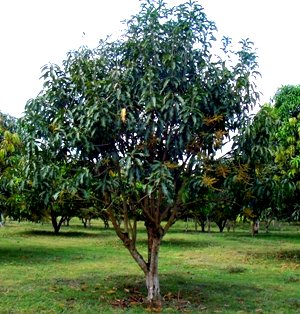Bare-root transplanting is also applicable in large and adult plants including mango trees.
Transplanting is the process of moving a plant from one area where it is growing to another area while bareroots are plants that are devoid of soil or any growing medium enclosing the roots.
In a way, the roots are “bare” or “naked,” as in seedlings that are uprooted by hand from a seedbed.
Bareroot transplanting is most common in backyard gardens, vegetable gardening, and landscaping.
Most vegetable seeds are sown first on seedbeds and several days later the seedlings are lifted and transplanted into plots or pots.
It is also common in plant nurseries where seeds of certain crops, like mango, should preferably be sown in seedbeds before potting or because there are no available pots, or where there is a program to mass-produce potted seedlings using wildlings.
Wildlings are seedlings that naturally grow on forest floors or below the canopy of certain crops.
In landscaping, bareroot ornamental plants such as snakeplant (Sansevieria spp.), agaves (Agave spp.), and many tuft-forming plants are normally planted only to be moved later to another location in the landscape.

There are innumerable plant species that can be propagated using wildlings.
Examples are coffee, many palms such as rattan, sweet palm, royal palm (Roystonea regia), fan palm (Livistona rotundifolia) and McArthur palm (Ptychosperma macarthurii), and many trees and shrubs including molave (Vitex parviflora).
Bare-root Seedlings and Wildlings
In 1999, we uprooted Robusta coffee wildlings at least the size of an ordinary pencil at Monkayo, T’boli in South Cotabato.
The wildlings were trimmed of excess primary roots, moistened and packed in containers to prevent dehydration, and transported to General Santos City by jeepney without exposing them to the sun.
Travel took 2 hours and two minutes halfway through a rough road.
The wildlings were then potted in black plastic bags. The survival rate was 100% under shade.
The potted wildlings remained in the nursery for about 6 months and, subsequently, some were outplanted in June, and in the following November to December the plants flowered.
The seedlings must have been old, similar to the so-called large planting materials or LPM.
Aside from coffee, we were also successful in transplanting bare-root seedlings of mango and citrus.
These were potted seedlings raised in the backyard for about a year.
During the onset of the rainy season, these were literally pulled out from their individual pots.
Sometimes the pots had to be smashed on the ground to break the hardened soil which held the roots.
The seedlings were inserted into a plastic sack, moistened, and the sack was tied close.
The seedlings were transported inside a non-airconditioned jeepney for about an hour with an additional hour of walking toward the farm.
Immediately upon arrival at the farm, the seedlings were planted. The survival rate was almost perfect.
We also tried it on jackfruit seedlings but failed.
Bare-root Transplanting of Mature Trees
But bare-root transplanting is not only for seedlings.
We have applied it also to mature plants such as molave, Dadiangas tree (Gmelina sp.) and bougainvilla, and to fruit trees and shrubs like mango, soursop (Annona muricata), kamias (Averrhoa bilimbi), guava (Psidium guajava), and Barbados cherry (Malpighia glabra).
For centuries, in fact, the use of bareroots in plant propagation has become a part of the amazing art of bonsai which now includes large bonsai generally consisting of tree specimens above one meter in height.
My friend Efren Sioquim excavated two adult mango trees (Mangifera indica), cut the primary root and the shoot leaving only short stubs of the lowermost scaffold branches, and transplanted them a short distance away in the open sun.
These mango trees were 12 years old but quite small in size with a trunk diameter of about 15 cm (6 in) above the graft union.
They were among those planted with a short spacing of 5 meters in an area where water was scarce.
The canopies having overlapped were intended to be removed as part of thinning operation in order to disperse the remaining trees.
Growth was rapid. In just two years, these transplanted mango trees started flowering.
In June 2011, the trees successfully responded to chemical floral induction.
This indicates that bare-root transplanting has vast potential in rescuing mature trees from total elimination as a result of thinning or any activity that may render them useless such as urban development or road construction.
To be clear, however, bare-root transplanting is not always a sure thing, especially with large trees.
The success story of adult mango and others mentioned above should rather be considered as an exception rather than a rule.
The author here is totally aware that technology needs plenty more effort to perfect.
He himself has in fact his own share of failures in applying the technology to many plants.
I Bare-root Coffee I Bare-root Guyabano I Bare-root Molave I
